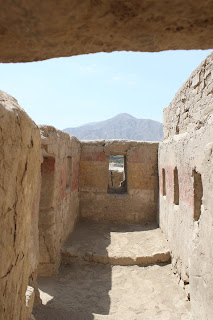13°48.19S
– 76°17.46W
A pleasant night run down the coast
brought us to the NE corner of the Peninsula Paracas and the pier at
General San Martin. This was named as the landing place by San Martin
when he launched the revolution. The land is barren, sandy, hilly
desert and the port is just a concrete parking lot where sand, salt
and guano are dumped then scooped into the holds of ships. Not much
to see to the West. Looking across the Bahia de Paracas to the East
we can see the low buildings of the town of Paracas and behind that
the Andes. ¾ of the peninsula is now protected as the Reserva
Nacional de Paracas. (Paracas means “storm of the sands.” for
almost every afternoon a sand storms blows by.) This is also noted
for being one of the driest places on earth. The islands off the
peninsula are white with guano and provide much needed fertilizer for
export and for the local farms. After a short drive through the
desert area we came to the Pan American Highway and soon were driving
through the irrigated areas where the crops are cotton, asparagus,
oranges and grapes.
About 35 miles inland from Pisco,
following the river flowing down from the Andes, we came to the
ruins (site) of the Incan village Tambo Colorado. (Red place of
rest). Here the village built on the side of the hill overlooks the
river and on the other side the site of a former pyramid. The
original (not re-built) walls still stand and in many places the
original red and yellow paint remains on the walls. The wood roofing
is long gone but with no rain here the rest is well preserved. We
walked the narrow hallways from room to room and enjoyed our guide's
lecture on the history of the site. Visit
www.archive.cyark.org/tambo-colorado-intro
for more. This was a quiet day in an out-of-the-way place and we were
the only group there.
Back down the highway to Hacienda
Huamani, a large farm raising asparagus, oranges and other fruit and
vegetables. Just entering the farm our vehicle had to be sprayed to
keep pests from being brought in. The Hacienda courtyard was prepared
with tables in the shade, poolside and serving tables for food and
beverages. I again declined the local “Pisco Sour” but did
consume a couple of tumblers of iced Inca-Cola. A music and dance
group “Blanco y Negro” from the Cultural Center in Chincha
performed
with music, song and dance of the
African heritage. African heritage? There was slavery here and it was
finally abolished but there remains some African (mostly Congo)
culture. A fine lunch of typical Peruvian fare was served buffet
style. (Visit www.haciendahuamani.com
.)
The final stop on the way back to the
ship was at the small factory Sumaqkay to observe hand operated looms
weaving Peruvian Cotton into rugs, wall hangings, material for
handbags and other things. In the courtyard a musical group played
the pan pipes, guitar and other traditional instruments. (Visit
www.sumaqkayparacas.com
)
.


















No comments:
Post a Comment